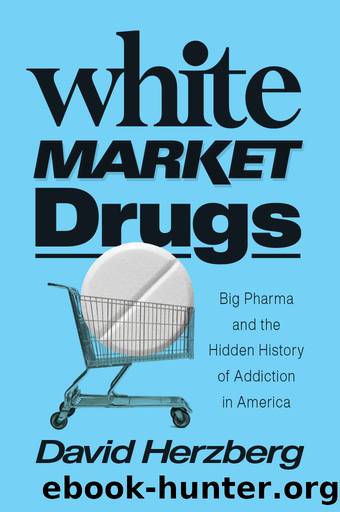White Market Drugs by David Herzberg

Author:David Herzberg [Herzberg, David]
Language: eng
Format: epub
Tags: MED000000 Medical / General
Publisher: University of Chicago Press
Published: 2020-11-12T00:00:00+00:00
Mood-control substances are legally available and their use is increasing with societyâs approval. Mood-control substances are illegally available and their use is increasing, but condemned by society. These two statements are contradictory, but both are true. As a matter of fact, in many instances the same drugs are involved. . . . [No wonder] we are rightfully charged with hypocrisy.â112
This kind of reasoning had surprisingly wide support during the congressional debates, probably because all factions could see it as a potential vehicle for their agenda. For medicalizers it held the promise of easing punitive controls over less harmful drugs like marijuana; for consumer advocates, increased controls over drugs like Valium; for moral crusaders, crackdowns on new informal markets for drugs like âspeedâ (amphetamine); and for the pharmaceutical industry, easing controls over unfairly maligned products.
While most of the congressional debate centered on the attorney generalâs role in making a final scheduling decision, there was unnoticed but remarkable unanimity on a much more radical issue: allowing the legal status of individual drugs to be changed administratively, without Congress having to pass a new law. As the head of the Bureau of Narcotics and Dangerous Drugs put it, the schedule was designed to be âflexible,â with substances able to change categories as âpublic interest dictates.â113 A version of the bill that required congressional approval before moving a drug from Schedule II to a less strict category was dropped, and the final bill allowed the attorney general to transfer or even remove âany drug or other substanceâ after making formal findings justifying the move.114
The Controlled Substances Act was thus at least potentially far more significant than initially intended.115 Obscured by Nixonâs public crime-fighting rhetoric, it contained the seeds of a dramatic rethinking of American drug policy. On the one hand, it accepted widespread use of addictive drugs while robustly regulating sales to protect and fully inform consumers. On the other hand, it reduced punishments for consumers while investing significant resources in providing treatment for those who developed addiction despite the protections.116 The radical possibility of seeing these reforms as two sides of the same coinâas a new template and rationale for drug policyâwas captured most fully by the Schedule of Controlled Substances itself, which offered the potential for evening out or even rationalizing the arbitrary and sometimes absurd binary categorization of addictive substances into medicines and ânarcotics.â
It is important not to go too far with this interpretation of the Controlled Substances Act. Medicalizers and consumer advocates still shared moral crusadersâ complete opposition to nonmedical drug use, and this consensus also marked the law. Consumer protection rhetoric and compassion for nonmedical drug users was explicitly linked to the supposedly new prevalence of drug use among Americaâs white middle classes. Senator Doddâs outrage came, in part, because he saw drug companies bringing addiction to places it did not belong. âHardened drug addictsâ using ânarcoticsâ in âthe slums and ghettos of our large citiesâ was one thing, but âcollege studentsâ and âyoung affluent professional people and other white collar workersâ hooked on pills was something else altogether.
Download
This site does not store any files on its server. We only index and link to content provided by other sites. Please contact the content providers to delete copyright contents if any and email us, we'll remove relevant links or contents immediately.
Life 3.0: Being Human in the Age of Artificial Intelligence by Tegmark Max(5502)
The Sports Rules Book by Human Kinetics(4333)
The Age of Surveillance Capitalism by Shoshana Zuboff(4238)
ACT Math For Dummies by Zegarelli Mark(4010)
Unlabel: Selling You Without Selling Out by Marc Ecko(3617)
Blood, Sweat, and Pixels by Jason Schreier(3581)
Hidden Persuasion: 33 psychological influence techniques in advertising by Marc Andrews & Matthijs van Leeuwen & Rick van Baaren(3511)
Bad Pharma by Ben Goldacre(3391)
The Pixar Touch by David A. Price(3386)
Urban Outlaw by Magnus Walker(3361)
Project Animal Farm: An Accidental Journey into the Secret World of Farming and the Truth About Our Food by Sonia Faruqi(3187)
Kitchen confidential by Anthony Bourdain(3042)
Brotopia by Emily Chang(3023)
Slugfest by Reed Tucker(2964)
The Content Trap by Bharat Anand(2883)
The Airbnb Story by Leigh Gallagher(2817)
Coffee for One by KJ Fallon(2594)
Smuggler's Cove: Exotic Cocktails, Rum, and the Cult of Tiki by Martin Cate & Rebecca Cate(2491)
Beer is proof God loves us by Charles W. Bamforth(2409)
